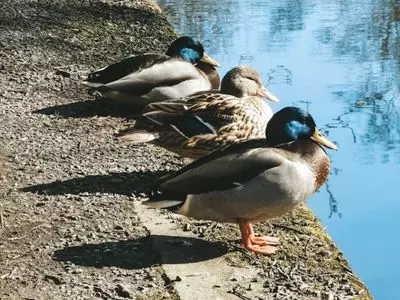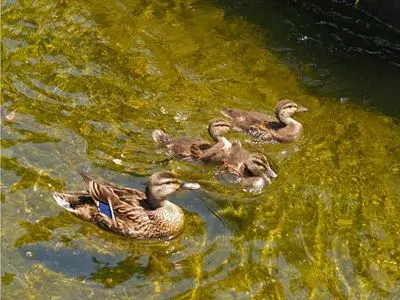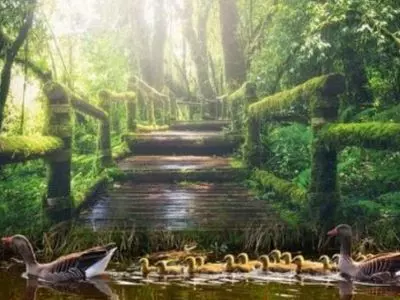No products in the cart.
Ducks
How to Keep a Duck Pond Clean NATURALLY in 2022
Ducks love to hang out by ponds and in water, but we need to know the proper way to keep it clean and safe for our ducks to swim in.
Knowing how to maintain a duck pond can turn your backyard into a relaxing oasis while also keeping your ducks happy and healthy.
In this guide, we’ll be going over how to keep a duck pond clean naturally! We’ll also cover how to care for man-made ponds.
*This post may have affiliate links, which means I may receive commissions if you choose to purchase through links I provide (at no extra cost to you). As an Amazon Associate I earn from qualifying purchases. Please read my disclaimer for additional details.
How to Keep a Duck Pond Clean

Importance
When ducks swim, they leave behind waste.
The accumulation of waste affects the chemistry of the water, which in turn makes it possible for the PH levels to shift and makes it easier for algae to develop.
This is one main reason that duck ponds get dirty so quickly.
Even though the ducks don’t appear to be bothered by the algae in and of itself, it can restrict the space in which they can swim and make it difficult for other animals in the water to breathe.
It can also make them sick if it happens to have bacteria or algae that are dangerous to the ducks.
Maintaining the natural order of the ecosystem is beneficial to the health of your ducks.
Read More: What is a Group of Ducks Called? Learn the different ways ducks are referred to!
Frequency of Cleaning
Even while natural ponds come with an ecosystem that helps with cleaning, it’s best to clean a duck pond at least once a week, even if it’s just a simple cleaning.
You will be able to inspect the pond, look for any other maintenance issues, and make sure the ducks are swimming in clean water when you check in every week.
Cleaning Natural Duck Ponds
It’s recommended that you put vegetation in your natural duck pond that contains native aquatic plants.
The plants not only make the environment more attractive but also assist oxygenate the water, which is necessary for preserving the PH balance and other forms of life in the pond.
Another great technique to keep the natural pond in good condition is to stock it with native fish.
These fish not only provide a food source for the ducks, but they also control the population of mosquitoes and other pesky insects.
As the fish swim through the water, they assist in maintaining a high oxygen content in the water.
Fountains and oxygenators are wonderful complements to any setting where additional oxygenation of the water is required.
You can choose oxygenators that deliver oxygen below the surface and are easily hidden so that they don’t affect the natural beauty of the pond.
Fountains are another decorative addition that can be added and can keep the surface of the water moving.
Read More: Why Do Ducks Quack? Ducks quack in order to communicate. Here’s what you need to know about duck sounds!
Aquatic Plants
Before introducing a plant into the ecosystem, you’ll need to determine whether or not the plant is native to the region, as some non-native plants can wreak havoc on the natural habitat.
Here’s a list of great plants to add to your pond:
- Water hyacinth
- Duckweeds
- Blossoms of Coontail
- Pickerelweed
- Cattail
- Potamogeton
- Lily
- Smartweed
Read More: Homemade Duck Egg Incubator. Raising ducklings is a challenging and fun experience! Here’s how to make an incubator at home.
Pond Animals
The same as with plants, selecting animals that are native to your region helps to preserve a healthy balance within the ecosystem of your pond.
Here’s a list of pond wildlife:
- Tilapias
- Minnows
- Crayfishes
- Catfishes
- Crappies
- Bullfrogs
- Bluegills
Read More: How to Catch a Duck. Catching a duck is sometimes necessary for health checks or relocation. Learn how to catch a duck in this guide!
Add Microbes
Ammonia, which is found in abundance in duck feces, is toxic to ducks as well as other aquatic species.
The transformation of ammonia into nitrogen, which is not toxic to the animals, is facilitated by the addition of enzymes such as Nitrobacter and Nitrosomonas.
So adding these microbes to your pond can help to level out the amount of ammonia sitting in the pond.
Barley Straw
You can choose to use barley straw in the form of an enzyme that is put into the pond or as a material that floats on the water.
This inhibits the growth of algae, which in turn helps to maintain a clean environment in the pond.
The straw can be easily replaced whenever it’s necessary to ensure that it’s clean and fresh for your ducks.
Read More: How to Train Ducks to Follow You… and other helpful training tips and tricks for free-range and pet ducks!
Aerators
Aerators can boost the oxygen content of any body of water.
Most aerators work like fountains, spraying water into the air at high pressure before allowing the droplets to fall back down, this time carrying additional oxygen.
Some aerators release oxygen-rich air into the water directly.
Keep it as Organic as Possible
It could be tempting to add pesticides or other treatments to your duck pond, but in most cases, the best course of action is to give the pond system some time to acclimatize to the ducks’ presence.
The natural world has a remarkable capacity to heal and restore itself.
So avoiding adding in any chemicals or extra stuff would actually be better for the pond than trying to maintain it with chemicals.
Read More: How Long Can Ducks Stay Underwater? You may have noticed ducks diving to feed on the bottom of a pond. How long can ducks hold their breath? We answer these questions here!
Cleaning Artificial Ponds

Because they typically do not include the natural flora and fauna that would allow them to self-clean in the same manner as a real pond, artificial ponds call for increased levels of upkeep and cleaning.
Keep in mind that the more space there is in the pond, the more difficult it will be to clean.
Pick a size that fits comfortably within your maintenance capabilities.
You can add plants and other critters to a duck pond, but you’ll want to be conscious of the size constraints and not overstock the pond with animals and plants.
This creates challenges for the ducks as well as the environment as a whole. The same plants and animals that were mentioned earlier will also work for an artificial pond.
Installing a drain in an artificial duck pond allows you to partially drain the pond once a month and refill it with new water, which is one of the easiest ways to keep the pond clean.
Read More: How to Clip Duck Wing Feathers. If you don’t want your ducks to fly away, you’ll need to clip their wings. Learn how!
Filtration
Artificial ponds can benefit from a filtration system by running the wastewater through a filter and then consistently replenishing the pond with new water.
Drain and Refill Routine
Altering the water in the pond regularly is another option to consider if you don’t have the resources (money or space) to build a recirculating system.
Every week or so, you should change the water in the container or pond.
Either a drainage pipe can be attached to the system to take the water and transmit it to a drainage system, or the water can be manually removed and then replaced.
Read More: Do Ducks Wag Their Tails When They Are Happy? Ducks do wag their tails when they’re happy – and for other reasons! Learn the reasons here.
Water Lillies
The aesthetic value and practical benefits of water lilies make them an excellent addition to any artificial duck pond.
Because water lilies restrict sunlight from reaching the pond’s bottom, they’re effective at controlling the number of algae that can develop there (which requires light to grow).
Read More: What Does it Mean When a Duck Shakes? Shivering can either be a good or bad sign in ducks. Learn the signs.
Surfactants
Because surfactants disrupt the surface tension of the water, the impurities in the water are pushed to the periphery, making cleanup much simpler.
When your ducks are actively swimming in the pool or pond, it’s important to avoid using surfactants.
Here’s a great video showing how to clean an artificial duck pond:
Read More: How Long Can Ducks Go Without Water? Water is essential to a duck’s well-being, but how long can ducks go without?
Final Thoughts
This article has highlighted some of the best, easiest, and most practical ways to clean and maintain a duck pond naturally!

